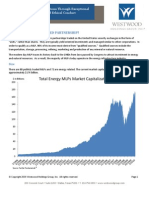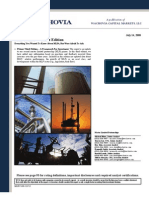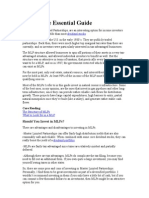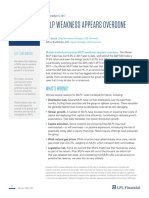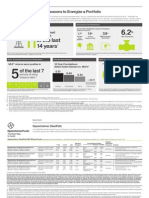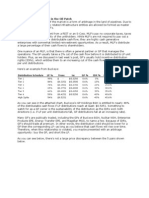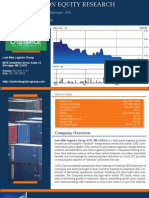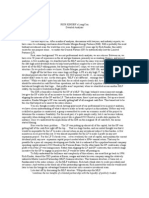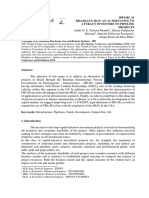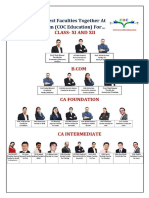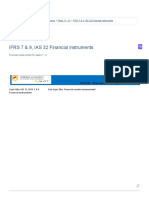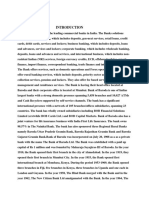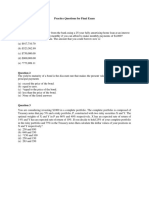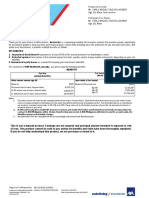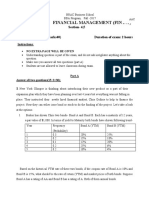MLP 101: An Investors Guide
THIS DOCUMENT IS FOR INFORMATIONAL PURPOSES ONLY AND IS NOT INTENDED TO BE, AND SHOULD NOT BE CONSTRUED AS, AN OFFER TO SELL, OR THE SOLICITATION OF AN OFFER TO BUY, ANY INTEREST IN ANY ENTITY OR OTHER INVESTMENT VEHICLE. IF SUCH AN INVESTMENT OPPORTUNITY SHOULD BECOME AVAILABLE, A CONFIDENTIAL PRIVATE PLACEMENT MEMORANDUM OUTLINING SUCH INVESTMENT OPPORTUNITY WOULD BE PROVIDED TO YOU, AND THE INFORMATION IN THIS DOCUMENT WOULD BE QUALIFIED IN ITS ENTIRETY BY REFERENCE TO ALL OF THE INFORMATION, INCLUDING WITHOUT LIMITATION THE RISK FACTORS, IN THE CONFIDENTIAL PRIVATE PLACEMENT MEMORANDUM. INVESTMENT IN ANY OF THE HARVEST MLP FUNDS INVOLVES SIGNIFICANT RISKS, INCLUDING, BUT NOT LIMITED TO, THE RISK THAT THE MLP SECTOR PERFORMS UNFAVORABLY. FOR A MORE DETAILED EXPLANATION OF RISKS, PLEASE REFER TO THE CONFIDENTIAL PRIVATE PLACEMENT MEMORANDUM. PAST PERFORMANCE IS NOT INDICATIVE OF FUTURE RESULTS. FUTURE RETURNS ARE NOT GUARANTEED, AND A LOSS OF PRINCIPAL MAY OCCUR.
�What are MLPs and PTPs?
Master Limited Partnership (MLPs) are passive investment vehicles where profits and losses are passed through the ownership structure to the limited partners. MLPs are limited partnerships which retain their partnership tax treatment. As such, the partnership itself does not pay entity level taxes. Rather, all tax items flow through to the partners, as long as 90% of its income is from qualifying sources. Publicly Traded Partnerships (PTPs) PTPs are limited partnerships (i.e., MLPs), the interests in which (known as units) are traded on public securities exchanges such as the NYSE. Buying MLP units makes you a limited partner in that PTP.
�MLPs: Real Assets
Real assets land, infrastructure, and raw materials, among other things are generally understood to be tangible assets with intrinsic value. These assets are also real in that they provide a real return rather than a nominal return and offer protection against inflation. In recent years, real assets have grown in popularity with institutional investors seeking diversified, inflation-protected returns. MLPs provide real asset exposure by means of ownership of energy infrastructure assets, including pipelines, terminals, and storage assets. Unlike many other real assets opportunities, MLPs feature the liquidity and daily pricing of a publicly-traded security. This removes a barrier of entry and is a unique advantage.
4.5
Real Asset Indexed Total Returns
4.0
3.5
3.0
2.5
2.0
1.5
1.0
0.5 Jan-02 Jan-03 Jan-04 Jan-05 Jan-06 Jan-07 Jan-08 Jan-09 Jan-10
S&P Global Timber TR Index S&P Global Infrastucture TR Index
Gold (Spot) S&P MLP TR Index
�MLP History
The modern MLP got its start with the Tax Reform Act of 1986. This legislation gave companies an incentive to restructure as publicly traded partnerships in order to take advantage of certain tax shelter benefits. In 1987, the Revenue Act was enacted, which required publicly traded partnerships to earn income only from specific sources (i.e., qualifying income). In the 1980s, MLPs were formed that were involved in various businesses including exploration and production (E&P) of oil and natural gas, restaurants, sports teams, and other consumer activities. The cyclical in nature of these businesses was not well-suited to an entity that distributed large amounts of its cash flow.
The M LP Universe
In the 1990s, MLPs were reincarnated as entities that generally own midstream assets used to transport, process, and store natural gas, crude oil, and refined petroleum products with limited exposure to commodity price risk. The early energy MLPs consisted primarily of refined-product pipelines that were characterized as mature assets that required modest maintenance capital and generated significant cash flows that were distributed to unit holders. By the mid-2000s, the majority of MLPs were energy related.
Real Estate 4% Minerals & Timber 2%
Mortgage Securities 2%
Investment/ Financial 9% Other 2%
Energy MLPs 81%
�MLP History (continued)
By 2000, energy MLPs began reorienting their focus towards growth, making acquisitions, accelerating internal projects, and aggressively raising distributions. As major diversified energy players sought to monetize mature assets and redeploy the proceeds into fastergrowing entities, the MLPs prospered. MLPs were able to take advantage of their unique tax structure which affords a lower cost of capital to acquire midstream assets and achieve superior returns compared to corporations.
Total Market Cap and Number of Energy MLPs $250
Market Cap ($ Billions)
74 74 68 69 $205
Expanding to 71
80 70
$200 $150
34 29 30 41
54 $158 $145
60 50
$102 $90
40 30
$100
17 15 12 12 18
23 $69 $56 $45 $26 $4 $2 $5 $7 $11 $10 $15 $29
20 10 0
$50 $0
9 7
1994
1995
1996
1997
1998
1999
2000
2001
2002
2003
2004
2005
2006
2007
2008
2009 YTD
MLP Market Cap
Number MLPs
�The Energy MLP Universe
Energy-related MLPs generally focus on pipeline assets, gas-producing assets, and bulk and liquids storage facilities that transport energy products (i.e., crude oil, natural gas, and refined products) to consumer markets of the commodities.
Natural Gas Pipeline & Storage MLPs Boardwalk Pipeline Partners, L.P. Chesapeake Midstream Partners, L.P. Duncan Energy Partners, L.P. El Paso Pipeline Partners, L.P. Energy Transfer Partners, L.P. Enterprise Products Partners L.P. Niska Gas Storage Partners, L.L.C. ONEOK Partners, L.P. PAA Natural Gas Storage, L.P. Spectra Energy Partners, L.P. TC Pipelines, L.P. Williams Pipeline Partners, L.P. (12) BWP CHKM DEP EPB ETP EPD NKA OKS PNG SEP TCLP WMZ Oil & Products Pipeline MLPs Blueknight Energy Partners LP Buckeye Partners, L.P. Enbridge Energy Partners, L.P. Holly Energy Partners, L.P. Kinder Morgan Energy Partners, L.P. Magellan Midstream Partners, L.P. NuStar Energy, L.P. Plains All American Pipeline, L.P. Sunoco Logistics Partners, L.P. TransMontaigne Partners, L.P. (10) BKEP BPL EEP HEP KMP MMP NS PAA SXL TLP Processor MLPs Atlas Pipeline Partners, L.P. Copano Energy, L.L.C. CrossTex Energy, L.P. DCP Midstream Partners, L.P. MarkWest Energy Partners, L.P. Quicksilver Gas Services, L.P. Regency Energy Partners, L.P. Targa Resources Partners, L.P. Western Gas Resources, L.P. Williams Partners, L.P. (10) APL CPNO XTEX DPM MWE KGS RGNC NGLS WES WPZ
General Partner Interests Alliance Holdings GP, L.P. Atlas Pipeline Holdings, L.P. Buckeye GP Holdings, L.P. Energy Transfer Equity, L.P. Enterprise GP Holdings L.P. Inergy Holdings, L.P. NuStar GP Holdings, L.L.C. Penn Virginia GP Holdings, L.P.
(8) AHGP AHD BGH ETE EPE NRGP NSH PVG
E&P MLPs BreitBurn Energy Partners, L.P. Constellation Energy Partners, L.P. Encore Energy Partners, L.P. EV Energy Partners, L.P. Legacy Reserves, L.P. Linn Energy, L.L.C. Pioneer Southwest Energy Partners, L.P. Vanguard Natural Resources, L.P
(8) BBEP CEP ENP EVEP LGCY LINE PSE VNR
Specialty MLPs Calumet Specialty Prod. Partners, L.P. Cheniere Energy Partners, L.P. Eagle Rock Energy Partners, L.P. Exterran Partners L.P. Genesis Energy, L.P. Global Partners, L.P. Martin Midstream Partners, L.P.
(7) CLMT CQP EROC EXLP GEL GLP MMLP
Propane MLPs AmeriGas Partners, L.P. Ferrellgas Partners, L.P. Inergy, L.P. Star Gas Partners, L.P. Suburban Propane Partners, L.P.
(5) APU FGP NRGY SGU SPH
Coal MLPs Alliance Resource Partners, L.P. Natural Resource Partners, L.P. Oxford Resource Partners, L.P. Penn Virginia Resource Partners, L.P.
(4) ARLP NRP OXF PVR
Shipping MLPs Capital Product Partners, L.P. K-Sea Transportation Partners, L.P. Navios Maritime Partners, L.P. Teekay LNG Partners, L.P. Teekay Offshore Partners, L.P.
(5) CPLP KSP NMM TGP TOO
�Partnership Mechanics GPs and LPs
MLPs are comprised of one or more general partner (the GP) and multiple limited partners (LP holders). General Partner (GP) A limited partnership can have one or more general partner that manage the partnership. The GP usually owns 2% of the partnership, is responsible for the operations and maintenance of the MLP, and has the authority to make decisions. Generally, the GP is eligible to receive incentive distributions as an incentive to grow the partnerships distributions. Limited Partner (LP) An LP provides capital to the partnership and receives a majority of the cash flows generated by the partnership through distributions. An LP has no decision making authority for the partnerships ownership and assets. Liability is limited to the amount of capital invested.
Capital
Master Limited Partnership (MLP)
Capital/ Management
Limited Partner (LP)
General Partner (GP)
�What is Qualifying Income?
In order to be an MLP, the partnership must have at least 90% of its income derived from the following qualified sources/activities:
Natural resources (exploration, mining, production, processing, refining, transportation, storage, and marketing of natural resources); Interest; Dividends; Real property rents; and Gain from sale or other disposition of real estate.
Transportation definition encompasses the following:
Includes any transport by pipeline of gas, oil or products thereof. Also includes transportation to a Bulk Distribution Center such as a terminal whether by pipeline, truck, barge, or rail; and Excludes transport of oil and gas to a place where it is dispensed or sold to retail customers (e.g., gas stations). Refiners and processors who acquire the oil or gas for further refining or processing are not considered retail customers.
�What is MLP-able?
Key Energy Characteristics
Process, store, and transport energy products for a fixed fee; Operate long-lived tolling assets; Are not linked to commodity prices (except for coal & upstream MLPs) and; Have high barriers to entry and; No electricity assets (e.g. power plant); no direct retail assets (e.g. gas station).
Midstream
Interstate Oil and Natural Gas Pipelines Intrastate Oil and Natural Gas Pipelines Petroleum Product Pipelines Gas Gathering and Processing Assets Facilities for Gas Compression, Treating, Fractionation, etc. Commodity Storage Facilities Compressor Stations Coal Preparation and Transloading Facilities Liquefied Natural Gas Tankers and Carriers Liquefied Natural Gas Regasification Facilities
Upstream
Oil Reserves Natural Gas Reserves Coal Reserves Other Exhaustible Ground Mineral and Natural Resources Drilling Platforms Drilling Rigs Other E&P Assets Used to Extract Exhaustible Ground Mineral and Natural Resources
Downstream
Transportation to Bulk Distribution Center such as a Terminal or Refinery by: Rail Cars Refineries Truck and Trailers Barges and Tugboats Propane Delivery and Service Vehicles
Other
Timber Geothermal Energy Sources Fertilizer Nitrogen and Sulfur Product Manufacturing Plants
Green
2
CO Sequestration Biodiesel Ethanol Blending & Storage
�What are MLP Distributions?
MLPs generally distribute available cash flow. Distributable cash flow is calculated as net income plus depreciation and other non-cash items, less maintenance capital expenditures. Unit holders receive distributions on a quarterly basis. These distributions are similar to dividends made by C-Corporations. Distributions reduce the unit holders original basis in their units.
�What are Incentive Distribution Rights (IDRs)?
IDRs are typically agreed to between the partnership and the GP. IDRs allocate the percentage of total cash distributions that are allocated between the GP and LPs. The GP is allocated an increasing share of cash distributions as certain targeted levels of cash distribution to the LPs are achieved. The IDR structure is intended to encourage the GP to operate the MLP in a manner that maximizes cash distributions to the unit holders. The GP is thereby financially motivated to improve performance and ratchet-up the distributions to the partnership.
�How are Distributions Allocated Between the LP and the GP?
MLPs have a standard distribution schedule for the percentage of cash that is distributed each quarter between the LP and the GP. The schedule allocates the distributions based on tiers or levels. The highest distribution tier is known as the High Splits. A hypothetical split arrangement is shown immediately below:
Distribution Schedule
Tier 1 Tier 2 Tier 3 Tier 4 (High Splits)
LP%
98% 85% 75% 50%
GP%
2% 15% 25% 50%
LP Distribution Up to
$1.00 $2.00 $3.00 Above $3.00
�How are Distributions Allocated Between the LP and the GP? (Continued)
To illustrate a hypothetical split, assume an MLP were to declare a distribution of $4.00 per LP unit. Based upon the distribution schedule in the previous slide, the distribution breakdown would be as follows:
Incremental Cash Distributions Per LP Unit Payment Tiers Tier 1 ($0.00-$1.00) Tier 2 ($1.00-$2.00) Tier 3 ($2.00-$3.00) Tier 4 (High Splits >$3.00) Total % of Total Cash Distribution LP $1.00 $1.00 $1.00 $1.00 $4.00 72% GP $0.02 $0.18 $0.33 $1.00 $1.53 28%
If the distribution is increased to $5.00 per limited unit, the formulas for tiers 1-4 would apply, and both the LP and GP would receive $1.00 for the incremental $1.00 increase (i.e., from $4.00 to $5.00).
�MLP Tax Basics
Due to their partnership structure, MLPs are not subject to corporate-level income tax on income they earn, unlike a corporation. This eliminates double taxation at the unit holder level. The MLP structure typically allows LP unit holders to receive a tax shield equivalent to 80-90% of their cash distributions in a given year. Deferred tax will not be paid until units are sold by the LP unit holder. The basis on LP units is stepped up upon death of the unitholder if passed to an heir as an estate planning strategy. Any losses incurred by the partnership passed through to unit holders are passive losses. These loses cannot be used by the unit holder to offset income from other sources. These losses can be carried forward and used to offset future income from the same MLP. Thus, an MLP investor typically pays income taxes roughly equal to 10-20% of their distribution. The remaining 80-90% is deferred until the investor sells the LP units.
�How is the MLP LP Investor Taxed?
Investors pay tax on their allocated share of partnership income and not on the cash distribution. An investors basis is calculated by taking the initial basis Plus allocated income less depreciation, Less the cash distribution. In the example below, 100 MLP units are purchased at $20 per unit; the 100 units are held for three years and then sold for approximately $22 per unit; yield is assumed at 7% annually, distribution growth is assumed at 5% annually, and capital appreciation is assumed at 7% annually; 90% of the allocated share of income is tax deferred (due to the depreciation tax shield); and taxes are paid on the non-shielded portion of income at an ordinary 35% tax rate.
Assump tio ns
Units Purchase Price Annual Distribution Yield Assumption Distribution Growth Rate Personal Tax Rate Tax Deferral Rate 100 $ 20 $ 1.40 7% 5% 35% 90% Initial Investment Distribution Tax Deferred Income (Tax Shield) Taxable Income Current Taxes Paid Implied Unit Price Cost Basis Year Per Unit $ 20 $ 1.40 $ 1.26 $ 0.14 $ 0.049 $ 20.00 $ 18.74 1 To tal ($ 2,000) $ 140.00 $ 126.00 $ 14.00 $ 4.90 $ 2,000 $ 1,874 Year 2 Per Unit To tal $ 1.47 $ 1.32 $ 0.15 $ 0.051 $ 21.00 $ 17.42 $ 147.00 $ 132.30 $ 15.00 $ 5.10 $ 2,100 $ 1,742 Year 3 Per Unit To tal $ 1.54 $ 1.39 $ 0.15 $ 0.054 $ 22.05 $ 16.03 $ 154.40 $ 138.90 $ 15.00 $ 5.40 $ 2,205 $ 1,603
�MLP Purchase and Sale Mechanics
In the example provided, after three years, the investors tax basis in the units would be reduced to $16.03.
Tax Implic ations -- Per L P Unit Original B as is MINUS: Cash Distributions PLUS: Taxable Income N et Reduc tio n in Co s t B as is Adjus ted B as is Year 1 $ 20.00 $ 1.40 $ 0.14 $ 1.26 $ 18.74 Year 2 $ 18.74 $ 1.47 $ 0.15 $ 1.32 $ 17.42 Year 3 $ 17.42 $ 1.54 $ 0.15 $ 1.39 $ 16.03
When the investor sells the units for $22.05 per unit at the end of year 3, they would realize a total gain of approximately $6.00 per unit, in addition to having received $4.41 per unit in cash distributions over the three year period. This includes a capital gain of $2.05 and ordinary income of about $4.00 per unit, which represents the recapture of depreciation and amortization deductions. Taxes would total $1.70 per unit, consisting of $0.31 in capital gains tax and $1.39 of ordinary income. On 100 units, this would be roughly $170. On a $2,000 investment over three years, an investor would earn a gross profit of $205 from the sale of the security, pay taxes on allocable net income over three years of $15.40, and pay long-term capital gains and ordinary income taxes totaling $170 at the time of sale. This represents an internal rate of return (IRR) of approximately 8.2%. This is an illustrative example only, and is not intended to demonstrate actual or typical MLP returns.
Year 3 Tax Co ns equenc es Proceeds From Sale Cost Basis Pretax Gain On Sale Pretax IRR After-Tax Gain On Sale After-Tax IRR
Per Unit $ 22.05 $ 16.03 $ 6.02 $ 4.32
To tal $ 2,205 $ 1,603 $ 602 11.20% $432 8.20%
Gains F rom Capital Appreciation Per Unit Capital Gain $ 2.05 Taxes on Capital Gain (15%) $ 0.31
Gains F ro m Red uctio n in B as is Recapture of Tax Shield Taxes on Ordinary Income (35%) Per Unit $ 3.97 $ 1.39
Total $ 205 $ 31
To tal $ 397 $ 139
�What is the K-1 Statement?
The Form K-1 that an MLP investor receives each year shows the investors share of the partnerships income, gain, loss, deductions, and credits. The Form K-1 is typically distributed in February and is similar to a Form 1099 issued by a corporation. The investor pays tax on the portion of net income allocated to them (which is shielded by losses, deductions, and credits) at their individual ordinary income tax rate. Typically, the Form K-1 statement is generated allocating partnership income and loss items to each State in which the partnership has operations. Investors are required to file income tax returns in each of these States, even if they do not have other sources of income from these States.
�Who Owns MLPs?
MLPs are typically owned by retail investors supported through major brokerage channels. 75% retail investors 25% institutions
�Disclosures
THIS INFORMATION DOES NOT CONSTITUTE AN OFFER TO SELL, OR A SOLICITATION OF AN OFFER TO BUY, AN INTEREST IN THE HARVEST MLP FUND (HARVEST OR THE FUND) OR ANY OTHER SECURITY. NO SUCH OFFER OR SOLICITATION WILL BE MADE PRIOR TO THE DELIVERY OF A CONFIDENTIAL PRIVATE PLACEMENT MEMORANDUM AND OTHER MATERIALS RELATING TO THE MATTERS MENTIONED HEREIN. BEFORE MAKING AN INVESTMENT DECISION WITH RESPECT TO THE FUND, POTENTIAL INVESTORS ARE ADVISED TO READ CAREFULLY THE CONFIDENTIAL PRIVATE PLACEMENT MEMORANDUM AND THE EXHIBITS AND RELATED DOCUMENTS. INVESTORS ARE ADVISED TO CONSULT THEIR TAX ADVISORS, FINANCIAL ADVISORS, AND LEGAL COUNSEL ABOUT ANY POTENTIAL INVESTMENT. THIS INFORMATION CONTAINS A SUMMARY OF BACKGROUND MLP INDUSTRY INFORMATION AND DOES NOT PURPORT TO BE COMPLETE. THIS INFORMATION IS QUALIFIED IN ITS ENTIRETY BY REFERENCE TO THE MORE DETAILED DISCUSSION CONTAINED IN THE CONFIDENTIAL PRIVATE PLACEMENT MEMORANDUM, THE EXHIBITS, AND RELATED DOCUMENTS. TAX MATTERS ARE VERY COMPLICATED, AND THE FEDERAL INCOME TAX CONSEQUENCES OF AN INVESTMENT IN THE HARVEST MLP FUND WILL DEPEND ON THE FACTS OF EACH INVESTORS SITUATION. INVESTORS ARE ENCOURAGED TO CONSULT THEIR OWN TAX ADVISERS REGARDING THE SPECIFIC TAX CONSEQUENCES THAT MAY AFFECT SUCH INVESTORS. CIRCULAR 230 NOTICE. THE FOLLOWING NOTICE IS BASED ON U.S. TREASURY REGULATIONS GOVERNING PRACTICE BEFORE THE U.S. INTERNAL REVENUE SERVICE: (1) ANY U.S. FEDERAL TAX ADVICE CONTAINED HEREIN IS NOT INTENDED OR WRITTEN TO BE USED, AND CANNOT BE USED BY ANY TAXPAYER, FOR THE PURPOSE OF AVOIDING U.S. FEDERAL TAX PENALTIES THAT MAY BE IMPOSED ON THE TAXPAYER; (2) ANY SUCH ADVICE IS WRITTEN TO SUPPORT THE PROMOTION OR MARKETING OF THE TRANSACTIONS DESCRIBED HEREIN; AND (3) EACH TAXPAYER SHOULD SEEK ADVICE BASED ON THE TAXPAYERS PARTICULAR CIRCUMSTANCES FROM AN INDEPENDENT TAX ADVISOR.

